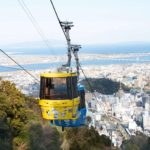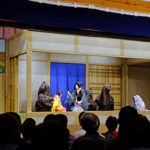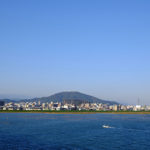Aizome (Indigo Dyeing)
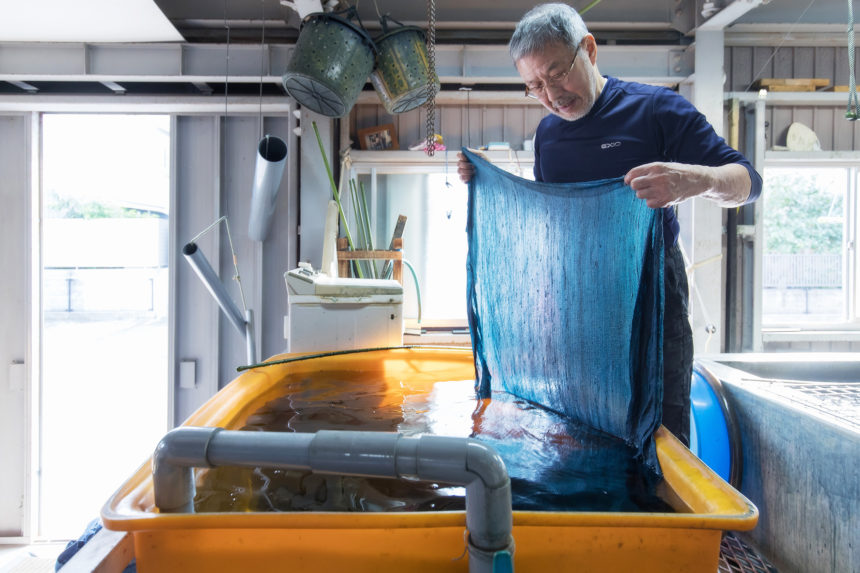
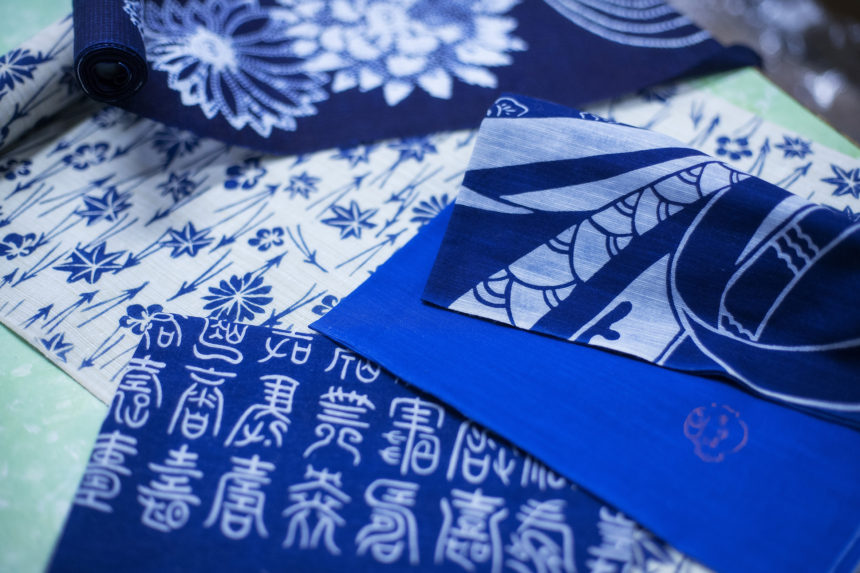 Tokushima Prefecture has a centuries-long history of indigo farming and dyeing. Locally grown indigo, known as Awa-ai, is prized for its high quality. Its production by traditional fermentation techniques, though labor-intensive and time-consuming, is still carried out today. It is said that the British chemist Robert William Atkinson (1850–1929) was impressed by the rich blue colors he saw upon visiting Japan in the 1870s. Atkinson coined the term “Japan Blue,” an expression now known worldwide, especially to fans of Japanese denim. Nearly 150 years later, the color indigo was chosen for the official emblems of the 2020 Tokyo Olympic and Paralympic Games. Visitors to Tokushima can experience a hands-on workshop in aizomeindigo dyeing.
The History of Indigo in Tokushima
The indigo plant is said to have come to Awa Province (the former name for Tokushima Prefecture) in the Muromachi period (1336–1573). The farming of it developed from the Edo period (1603–1868). Cultivation spread from mountainous areas to the fields alongside the Yoshino River, which runs across the northern part of the prefecture. Frequent flooding makes this area unsuitable for rice farming, but the rich soil and abundance of water were well-suited to indigo. The first lord of Tokushima, Hachisuka Iemasa (1558–1638), promoted its cultivation and the establishment of what was to become a booming industry.
By the early Edo period (1603–1868) an increase in cotton production contributed to a nationwide demand for Awa-ai, as its pigment was used widely in dyeing. Indigo blue was one of the few bright colors that commoners were permitted to wear in the strict days of samurai rule. This helped to increase demand even more.
Indigo cultivation peaked in 1903, then dropped as cheaper synthetic substitutes were imported from overseas. The tradition of indigo production in Tokushima never completely died out, however. In recent years, interest in natural products and traditional methods of craft production have helped to raise Awa-ai’s profile once again.
The Indigo Dyeing Process
While each Awa indigo producer brings their own special techniques to pigment production and indigo dyeing, the basic procedure is similar. The leaves of the indigo plants are ground and dried, then splashed with water and allowed to ferment for about three months. This produces a pungent substance called sukumo, the base for dyeing. The pigment at this stage, however, is not yet water-soluble, and requires further processing. The sukumois mixed with a glucose solution and sake or wheat bran, then fermented again at carefully controlled temperatures for another week or so.
Once the dye bath is ready, the cloth is dipped into it repeatedly. With each immersion, a new layer of blue depth is slowly revealed. After the cloth is thoroughly rinsed in clean water and allowed to dry, the bright color of indigo will deepen over time.
A number of workshops in the city of Tokushima offer visitors the chance to try indigo dying and produce a one-of-a-kind souvenir
Tokushima Prefecture has a centuries-long history of indigo farming and dyeing. Locally grown indigo, known as Awa-ai, is prized for its high quality. Its production by traditional fermentation techniques, though labor-intensive and time-consuming, is still carried out today. It is said that the British chemist Robert William Atkinson (1850–1929) was impressed by the rich blue colors he saw upon visiting Japan in the 1870s. Atkinson coined the term “Japan Blue,” an expression now known worldwide, especially to fans of Japanese denim. Nearly 150 years later, the color indigo was chosen for the official emblems of the 2020 Tokyo Olympic and Paralympic Games. Visitors to Tokushima can experience a hands-on workshop in aizomeindigo dyeing.
The History of Indigo in Tokushima
The indigo plant is said to have come to Awa Province (the former name for Tokushima Prefecture) in the Muromachi period (1336–1573). The farming of it developed from the Edo period (1603–1868). Cultivation spread from mountainous areas to the fields alongside the Yoshino River, which runs across the northern part of the prefecture. Frequent flooding makes this area unsuitable for rice farming, but the rich soil and abundance of water were well-suited to indigo. The first lord of Tokushima, Hachisuka Iemasa (1558–1638), promoted its cultivation and the establishment of what was to become a booming industry.
By the early Edo period (1603–1868) an increase in cotton production contributed to a nationwide demand for Awa-ai, as its pigment was used widely in dyeing. Indigo blue was one of the few bright colors that commoners were permitted to wear in the strict days of samurai rule. This helped to increase demand even more.
Indigo cultivation peaked in 1903, then dropped as cheaper synthetic substitutes were imported from overseas. The tradition of indigo production in Tokushima never completely died out, however. In recent years, interest in natural products and traditional methods of craft production have helped to raise Awa-ai’s profile once again.
The Indigo Dyeing Process
While each Awa indigo producer brings their own special techniques to pigment production and indigo dyeing, the basic procedure is similar. The leaves of the indigo plants are ground and dried, then splashed with water and allowed to ferment for about three months. This produces a pungent substance called sukumo, the base for dyeing. The pigment at this stage, however, is not yet water-soluble, and requires further processing. The sukumois mixed with a glucose solution and sake or wheat bran, then fermented again at carefully controlled temperatures for another week or so.
Once the dye bath is ready, the cloth is dipped into it repeatedly. With each immersion, a new layer of blue depth is slowly revealed. After the cloth is thoroughly rinsed in clean water and allowed to dry, the bright color of indigo will deepen over time.
A number of workshops in the city of Tokushima offer visitors the chance to try indigo dying and produce a one-of-a-kind souvenir
<簡体字>
蓝染(靛蓝染色)
德岛县拥有数百年的蓼蓝(含靛蓝较多的一种植物)种植和染色历史。当地种植的蓼蓝被称为“阿波蓝”,因其高品质而备受推崇。德岛蓝染采用传统发酵工艺,虽然费时费力,但一直被坚持至今。据说,英国化学家罗伯特·威廉·阿特金森(Robert William Atkinson,1850-1929)在1875年访问日本时,对这种浓郁的蓝色留下了深刻印象,遂创造了“日本蓝”一词。如今,“日本蓝”早已举世闻名,对于日本牛仔布的拥趸而言更是耳熟能详。约150年后,靛蓝被选为2020东京奥运会和残奥会的官方会徽色。来访者可以在德岛的蓝染工坊亲身体验这项染色工艺。
德岛的蓼蓝种植史
据传,蓼蓝在室町时代(1336-1573)传入阿波国(德岛县旧称),至江户时代(1603-1868)发展起来。蓼蓝的种植遍及山区到吉野川(贯穿德岛县北部的河流)流域的田地。该地区频频遭遇洪水之苦,水稻难以种植,但由此带来的肥沃土壤和充足水分却恰好适合蓼蓝生长。德岛第一任藩主蜂须贺家政(1558-1638)积极推进蓼蓝的种植,为后来繁荣兴盛的蓝染产业奠定了基础。
江户时代早期,棉花产量的增长带动了全国各地对于阿波蓝的需求,这种染料被广泛用于染色。在阶级区分严苛的武士时代,平民服饰不得过度奢华艳丽,靛蓝是他们为数不多的可选颜色之一,这进一步增加了人们对于阿波蓝的需求。
德岛的蓼蓝种植在1903年达到顶峰,此后,随着更便宜的合成替代品从海外流入,种植量开始减少。然而,德岛传统的靛蓝染料生产方式从未完全消失。近年来,人们对天然产品和传统手工艺的兴趣渐浓,阿波蓝因此再度受到关注。
靛蓝染色工艺
虽然每个阿波靛蓝生产商都有染料生产和靛蓝染色的独门秘方,但基本工艺都相似。
首先将蓼蓝的叶子磨碎、晒干,再洒上水,发酵约三个月后会产生一种叫“蒅”的刺激性物质,它是染色料的基础成分。在这个阶段,染料尚不溶于水,需要进一步加工。
随后,将“蒅”与清酒或麦麸混合,在精心控制的温度下再发酵一周左右,才能加工成可用的染料。
染缸准备好后,将布料反复浸泡其中。每一次浸泡,布料都会呈现出新一层更深的蓝色。最后,用清水将布料彻底冲洗干净并晾干,鲜艳的靛蓝会随着时间的推移而渐渐变深。
德岛市的许多工坊都为来访者提供尝试靛蓝染色的机会,人们可以在那里制作出独一无二的专属纪念品。
<繁体字>
藍染(靛藍染色)
德島縣擁有數百年的蓼藍(含靛藍較多的一種植物)種植和染色歷史,當地種植的蓼藍被稱為「阿波藍」,因品質優良而備受推崇。德島藍染採用傳統發酵工藝,雖然費時費力,但一直被堅持至今。據說,英國化學家羅伯特·威廉·阿特金森(Robert William Atkinson,1850-1929)於1875年訪問日本時,便對這種濃郁的藍色留下了深刻印象,遂創造了「日本藍」一詞。如今,「日本藍」早已舉世聞名,對於日本牛仔布的愛好者而言更是耳熟能詳。近150年後,靛藍被選為2020東京奧運會和帕奧會的官方會徽色。遊客可以在德島的藍染工坊親身體驗這項染色技藝。
德島的蓼藍種植史
據傳蓼藍於室町時代(1336-1573)傳入阿波國(德島縣舊稱),在江戶時代(1603-1868)發展起來。蓼藍的種植遍及山區到吉野川(貫穿德島縣北部的河流)流域的田地。當地頻頻遭遇洪水之苦,水稻難以種植,但由此帶來的肥沃土壤和充足水分卻剛好適合蓼藍生長。德島第一任藩主蜂須賀家政(1558-1638)積極推進蓼藍的種植,為後來繁榮興盛的藍染產業奠定了基礎。
江戶時代早期,棉花產量的增加帶動了全國各地對於阿波藍的需求,這種染料被廣泛用於染色。在階級區分嚴苛的武士時代,平民的服飾不得過度奢華豔麗,靛藍是他們為數不多的可選顏色之一,這也進一步推動了人們對於阿波藍的需求。
德島的蓼藍種植在1903年達到頂峰,此後,隨著更便宜的合成替代品從海外引入,種植開始減少。然而,德島傳統的靛藍染料生產方式從未因此消失。近年來,人們對天然產品和傳統手工藝的興趣漸濃,阿波藍因此再度受到關注。
靛藍染色工藝
雖然每家阿波靛藍生產商都有染料生產和靛藍染色的獨門秘方,但工藝基本都十分相似。
首先將蓼藍的葉子磨碎、曬乾,再灑上水,讓其發酵約三個月,就會產生一種叫「蒅」的刺激性物質,這是染色料的基礎成分。在這個階段,染料尚不溶於水,還需進一步加工。
隨後,將「蒅」和清酒或麥麩混合,在精心控制的溫度下再發酵一周左右,才能加工成可用的染料。
染缸準備好後,將布料反復浸入其中,每一次浸泡,布料都會呈現出新一層更深的藍色。最後,用清水將布料徹底沖洗乾淨並晾乾,鮮豔的靛藍會隨著時間的推移而漸漸變深。
德島市的許多工坊都開放遊客體驗靛藍染色的機會,人們可以在那裡製作出獨一無二的專屬紀念品。
Hyotanjima Cruise

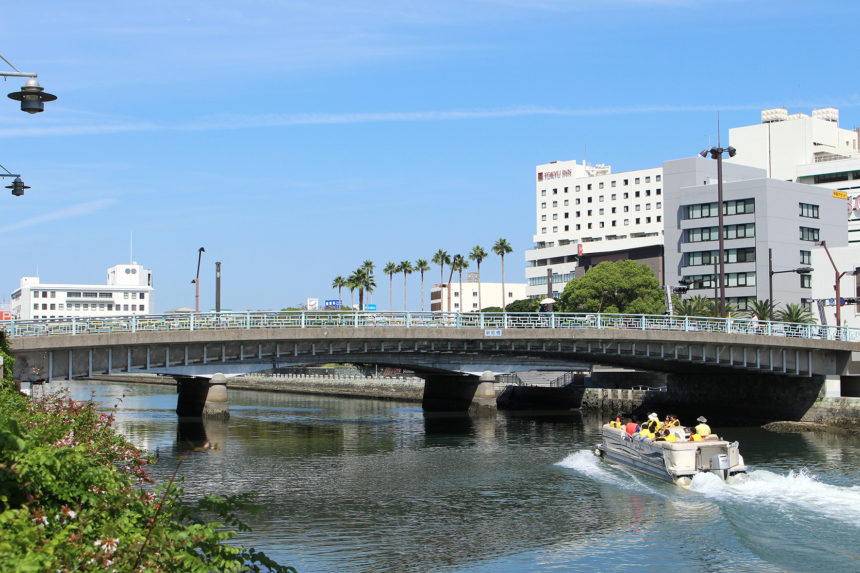 Tokushima is nicknamed “The City of Water.” This scenic cruise, which lasts about thirty minutes, ferries visitors along the waterways and under the bridges that characterize the capital. The ride takes its name, meaning “Gourd Island,” from the shape of the city center—an area of about six kilometers, bordered by two rivers.
Embarking from the floating pier of Ryogokubashi Bridge Kitazume, the cruise boats travel the Shinmachi and Suketo Rivers in a circular route, passing under 19 bridges along the way. When water levels are high, the boats only just manage to squeeze under some of them, adding a note of excitement to the journey. Passengers will see various areas of the city, both residential and commercial, as well as the yacht harbor and a number of attractive riverside parks. Although the cruise itself is free, there is a small fee for insurance purposes. Advance reservations are not required.
Tokushima is nicknamed “The City of Water.” This scenic cruise, which lasts about thirty minutes, ferries visitors along the waterways and under the bridges that characterize the capital. The ride takes its name, meaning “Gourd Island,” from the shape of the city center—an area of about six kilometers, bordered by two rivers.
Embarking from the floating pier of Ryogokubashi Bridge Kitazume, the cruise boats travel the Shinmachi and Suketo Rivers in a circular route, passing under 19 bridges along the way. When water levels are high, the boats only just manage to squeeze under some of them, adding a note of excitement to the journey. Passengers will see various areas of the city, both residential and commercial, as well as the yacht harbor and a number of attractive riverside parks. Although the cruise itself is free, there is a small fee for insurance purposes. Advance reservations are not required.
<簡体字>
葫芦岛游船
德岛素有“水之都”的美誉。这条风景优美的水上巡游路线大约需要30分钟,乘客们可以游览这座城市最具代表性的水路和桥梁。“葫芦岛”这样有趣的名字来自于德岛市中心的地形:这是一片周长约6公里的区域,交汇的两条河流围出了一个葫芦的形状。
游船从两国桥北诘的浮桥码头出发,沿新町川和助任川两条河流环绕一周,沿途会经过19座桥。遇到水位高涨时,游船只能紧贴着桥底“挤”过去,为旅途平添几许兴奋刺激。沿途可以观赏到城市不同区域,包括住宅区、商业区、游艇码头和一些美丽的沿河公园。游船本身免费,但要收取小额保险费,无需预约。
<繁体字>
葫蘆島遊船
德島素有「水之都」的美譽,這條風景優美的水上巡迴路線需約30分鐘,乘客們可盡情遊覽城市最具代表性的水路和橋樑。「葫蘆島」這有趣的名字來自於德島市中心的地形:這是一片周長約6公里的區域,交匯的兩條河流環繞出一個葫蘆的形狀。
遊船從兩國橋北詰的浮橋碼頭出發,沿新町川和助任川兩條河流環繞一周,一路上會經過19座橋。遇到水位高漲時,遊船只能緊貼著橋底「擠」過去,為旅途增添些許刺激。沿途可以遊賞城市不同區域,包括住宅區、商業區、遊艇碼頭和美麗的沿河公園。遊船本身免費但要收取小額保險費,不需要預訂。
Yusanbako (Wooden Lunch Boxes)
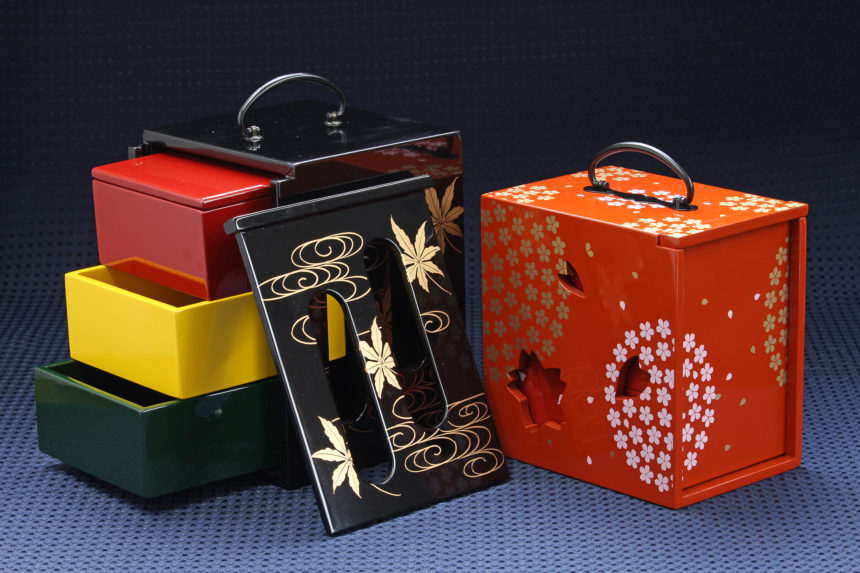 Three-tiered, lacquered, wooden lunch boxes, known as yusanbako, were a staple of childhood in Tokushima.Children carried the colorful lunch boxes when they went to the fields, the mountains, or the beach with their friends. Although yusanbakofell out of daily use from the 1960s, recent efforts by researchers and craftspeople have resulted in a renewed interest in the custom.
A Childhood Tradition
The yusanbakois a set of three small, square-shaped stacking trays fit into a boxed frame. A vertically sliding lid keeps the trays securely in place. When it is time to eat, the lid is pulled up and out to reveal the drawers inside. The whole is carried by a handle set on the top.
Traditionally, the bottom tier of the yusanbakowould be filled with some form of rice, such as sushi, or sweet and tangy inarizushi—pockets of fried tofu stuffed with rice. The middle tray would hold simmered vegetables, while the top was reserved for something sweet. One treat especially popular among children in Tokushima was uiro, a steamed cake made of rice flour and sugar.
The yusanbakotradition has roots in Tokushima’s agricultural heritage. At a time when much of the population lived in small farming communities, daily life revolved around the seasons. The coming of spring was celebrated with a rare day off, when villagers would enjoya picnic together outdoors.
The design of yusanbakodeveloped from larger three-tiered boxes designed to carry food for an entire family. Smaller versions for children probably appeared toward the end of the Edo period (1603–1868). Yusanbakowith painted designs grew in popularity during the Meiji era (1868–1912). In time, they came to be associated with Hinamatsuri, or the Doll’s Festival.
In Tokushima, both girls and boys would gather with friends for a picnic lunch to mark this rite of spring. Many older residents still have fond childhood memories of their yusanbakoand those festive excursions with schoolmates. Typically, each child of elementary school age had his or her own box that would be brought out yearly just for this occasion.
As families became smaller and more people moved from agriculture to other kinds of work in the days of economic expansion after World War II, demand for yusanbakodeclined, as did the number of craftspeople making them.
Yusanbako Today
The publication of a 2006 book by Miyake Masahiro, an academic and researcher with an interest in food culture, helped to revive the tradition of yusanbako. He collaborated with local craftspeople to come up with a simpler, less expensive alternative to the original version. Yusanbakopainting workshops have since become a popular activity with families and school groups, as well as visitors who want a one-of-a-kind souvenir from Tokushima.
The traditional lacquered yusanbako are also available, and may be purchased as a special gift for a new bride or to celebrate a baby’s birth. People sometimes use the lunch boxes for decorative purposes, or to store and display things such as confectionery or accessories. In addition, groups with an interest in history or food culture hold lectures or events to promote appreciation of this aspect of childhood culture in Tokushima.
Three-tiered, lacquered, wooden lunch boxes, known as yusanbako, were a staple of childhood in Tokushima.Children carried the colorful lunch boxes when they went to the fields, the mountains, or the beach with their friends. Although yusanbakofell out of daily use from the 1960s, recent efforts by researchers and craftspeople have resulted in a renewed interest in the custom.
A Childhood Tradition
The yusanbakois a set of three small, square-shaped stacking trays fit into a boxed frame. A vertically sliding lid keeps the trays securely in place. When it is time to eat, the lid is pulled up and out to reveal the drawers inside. The whole is carried by a handle set on the top.
Traditionally, the bottom tier of the yusanbakowould be filled with some form of rice, such as sushi, or sweet and tangy inarizushi—pockets of fried tofu stuffed with rice. The middle tray would hold simmered vegetables, while the top was reserved for something sweet. One treat especially popular among children in Tokushima was uiro, a steamed cake made of rice flour and sugar.
The yusanbakotradition has roots in Tokushima’s agricultural heritage. At a time when much of the population lived in small farming communities, daily life revolved around the seasons. The coming of spring was celebrated with a rare day off, when villagers would enjoya picnic together outdoors.
The design of yusanbakodeveloped from larger three-tiered boxes designed to carry food for an entire family. Smaller versions for children probably appeared toward the end of the Edo period (1603–1868). Yusanbakowith painted designs grew in popularity during the Meiji era (1868–1912). In time, they came to be associated with Hinamatsuri, or the Doll’s Festival.
In Tokushima, both girls and boys would gather with friends for a picnic lunch to mark this rite of spring. Many older residents still have fond childhood memories of their yusanbakoand those festive excursions with schoolmates. Typically, each child of elementary school age had his or her own box that would be brought out yearly just for this occasion.
As families became smaller and more people moved from agriculture to other kinds of work in the days of economic expansion after World War II, demand for yusanbakodeclined, as did the number of craftspeople making them.
Yusanbako Today
The publication of a 2006 book by Miyake Masahiro, an academic and researcher with an interest in food culture, helped to revive the tradition of yusanbako. He collaborated with local craftspeople to come up with a simpler, less expensive alternative to the original version. Yusanbakopainting workshops have since become a popular activity with families and school groups, as well as visitors who want a one-of-a-kind souvenir from Tokushima.
The traditional lacquered yusanbako are also available, and may be purchased as a special gift for a new bride or to celebrate a baby’s birth. People sometimes use the lunch boxes for decorative purposes, or to store and display things such as confectionery or accessories. In addition, groups with an interest in history or food culture hold lectures or events to promote appreciation of this aspect of childhood culture in Tokushima.
<簡体字>
游山箱(木制便当盒)
“游山箱”是一种手提的三层漆木便当盒,它是独属于德岛的童年记忆。从前,德岛的孩子都会带着五颜六色的便当盒和朋友们一起去田野、山间或海滩游玩。但从20世纪60年代开始,游山箱就退出了人们的日常生活。近年来,在研究人员和工匠们的努力下,它又重新赢得了关注。
童年旧事
游山箱是一种套装餐盒:三个上下叠放的抽屉式小餐盘,装在一个外箱之中。箱子的顶部有一个把手,便于手提。一块可上下滑动的侧板起到了固定餐盘的作用。吃饭时,只要向上拉出侧板,就能将箱中的三个小餐盘逐一取出。
传统上,游山箱的底层用于摆放米饭类主食,比如寿司或甜咸口味的稻荷寿司(塞满米饭的油炸豆腐包);中层放炖煮的蔬菜;顶层则用来放甜食。用米粉和糖混合后蒸制而成的外郎糕是德岛孩子的最爱。
游山箱的传统源自于德岛的农业遗风。在大部分人口以小型农业社区聚居的时代,日常生活与季节息息相关。为庆祝春天到来,村民们就会在难得的假期里一起享受户外野餐。
最初的游山箱是比现在更大的三层餐盒,当时是为整个家庭出游而设计的。较小的儿童式样可能出现在江户时代(1603-1868)末期。到了明治时代(1868-1912),带有彩绘图案的游山箱越来越受欢迎,并开始跟女儿节(偶人节,阴历三月三日)联系在一起。
当时在德岛,无论男孩女孩,都会在女儿节这个春天特别的节日里和朋友们相聚野餐,享用午饭。每个小学生都有属于自己的游山箱,并且每年只在这个节日拿出来使用。昔日的游山箱、节日里和校友们一起远足的时光,是许多年长者对美好童年的记忆。
二战后经济扩张,家庭单位变小,越来越多的人从农业转向其他行业,人们对游山箱的需求逐渐下降,工匠数量也随之减少。
今日游山箱
2006年,对饮食文化感兴趣的学者兼研究员三宅正弘出版了一本书,带动了游山箱这一传统的复兴。他与当地工匠合作,开发出一种更简单、更便宜的替代品。游山箱绘画工作室的体验活动从此流行起来,它不仅深受家庭和学校团体欢迎,也得到了游客的青睐,因为他们在德岛能获得独一无二的专属纪念品。
如今,人们会购买传统的漆木游山箱作为送给新娘或庆祝婴儿出生的特别礼物,也会将这种便当盒作为装饰品,或用于存放和展示糖果、配饰之类的物品。此外,关注历史或饮食文化的组织也会举办相关讲座或活动,让更多人了解德岛昔日的童年文化。
<繁体字>
遊山箱(木製便當盒)
「遊山箱」是一種手提的三層漆器木便當盒,是獨屬於德島人的童年記憶。從前,德島的孩子都會帶著五顏六色的便當盒和朋友們一起去田野、山間或海灘遊玩。從1960年代開始,遊山箱就退出了人們的日常生活,但在研究人員和工匠們的努力下,近來又重新獲得了關注。
童年舊事
遊山箱是一套三個上下疊放的方形小餐盤裝在一個外箱之中的餐盒,箱子的頂部有一個把手便於手提。一塊可上下滑動的側板發揮了固定餐盤的作用。吃飯時,只要向上拉出側板,就能將箱中的三個小餐盤逐一取出。
傳統上,遊山箱的底層用於擺放米飯類主食,比如壽司或帶點鹹甜的稻荷壽司(塞滿壽司飯的油炸豆腐包);中層放燉煮蔬菜;頂層則用來放甜食。用米粉和糖混合後蒸製而成的外郎糕是德島孩子的最愛。
遊山箱的傳統源自於德島的農業遺風,在大部分人口以小型農業社區聚落發展的時代,日常生活與季節息息相關,為慶祝春天到來,村民們就會在難得的假期裡一起享受戶外野餐。
最初的遊山箱是比現在更大的三層餐盒,當時是為整個家庭出遊而設計的,較小的兒童版本可能出現在江戶時代(1603-1868)末期。到了明治時代(1868-1912),帶有彩繪圖案的遊山箱越來越受歡迎,並開始跟女兒節(人偶節,陰曆三月三日)連結在一起。
當時在德島,無論男孩女孩都會在女兒節這春天的節日和朋友們相聚野餐,享用午飯,每個小學生都有屬於自己的遊山箱,每年就在女兒節這天帶出來郊遊野餐。自己的遊山箱、和學校的朋友們一起在節日遠足的時光,是許多上了年紀的居民的美好童年回憶。
二戰後隨著經濟發展家庭人數變少,越來越多的人從農業轉向其他類型的工作,人們對遊山箱的需求逐漸下降,而工匠數量也隨之減少。
今日遊山箱
2006年,對飲食文化感興趣的學者兼研究員三宅正弘出版了一本書,帶動了遊山箱這一傳統的復興,他與當地工匠合作,開發出一種更簡單、更便宜的替代品。遊山箱繪畫工作室的體驗活動從此流行起來,深受家庭和學校團體歡迎,也得到了遊客的青睞,讓他們能在德島獲得獨一無二的專屬紀念品。
如今,人們會購買傳統的漆木遊山箱作為送給新娘或慶祝嬰兒出生的特別禮物,也會將這種便當盒作為裝飾品,或用於存放和展示糖果、飾品之類的物品。此外,關注歷史或飲食文化的組織也會舉辦相關講座或活動,讓更多人瞭解德島昔日的童年文化。
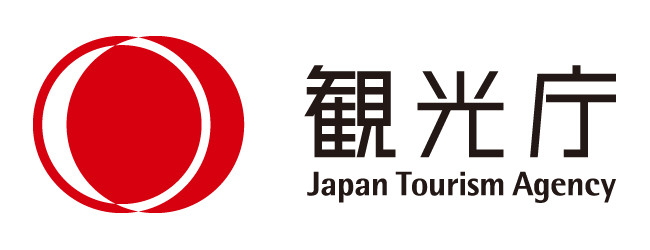 This English-language text was created by the Japan Tourism Agency.
This English-language text was created by the Japan Tourism Agency. 


